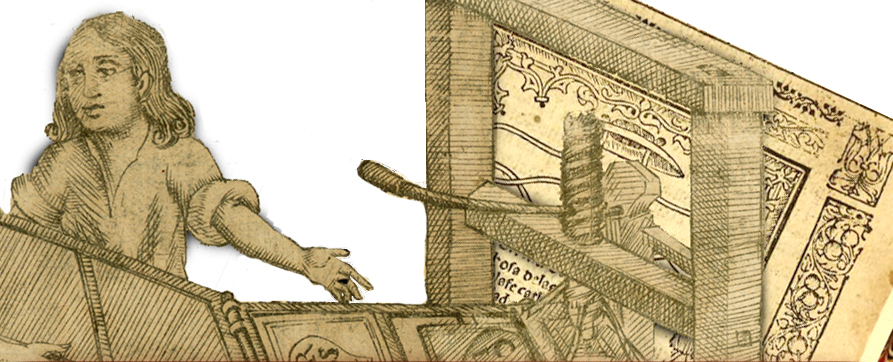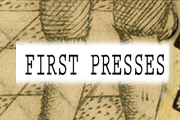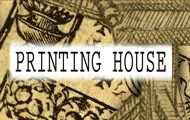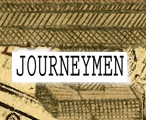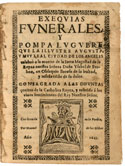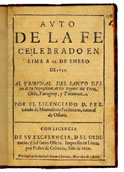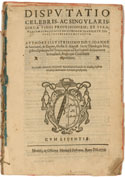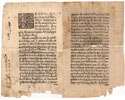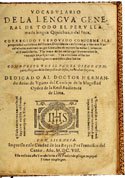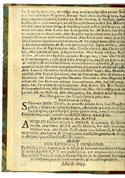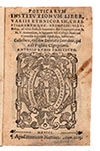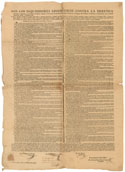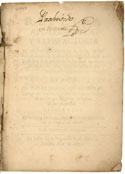| Beyond the owners of the presses named in the imprints, the journeymen and apprentices responsible for making the ink, pulling the bar of the press and all the other tasks are rarely discussed in the literature and, indeed, only infrequently appear in the documentary record. |
||
 |
||
| A Documented Apprentice 26. Puebla (Mexico), Exequias funerales, y pompa lugubre, que la illustre augusta, y muy leal ciudad de los Angeles celebrò a la muerte de la sacra magestad de la reyna nuestra señora doña Ysabel de Borbon (Con licencia en la Puebla: Por Manuel de los Olibos, 1645). Apprentices in the Latin American book trade are poorly documented. One that we know of was Manuel de los Olivos, an orphan from Jeréz de la Frontera, Spain. On 30 January 1642, Olivos entered into apprenticeship with Juan Blanco de Alcázar in Puebla de los Angeles. Three years later, two books appeared with his name in the imprint, perhaps signaling that he had moved from apprentice to journeyman. No other books with his imprint appear in the bibliographical record, until 1665, when he began printing in Lima. |
||
| 27. Inquisition. Peru, Auto de la fe celebrado en Lima a 23. de enero de 1639 (Impresso en Lima: por Pedro de Cabrera; año de [1639]. Vendense en la tienda de Simon Chirinos, mercader de libros, 1639). Pedro de Cabrera of Seville was formally apprenticed to Jerónimo de Contreras on 31 March 1622. The apprenticeship was to last for four years, with Contreras providing food, clothing, and housing, along with 100 pesos per year. The contract was severed on 13 February 1624, however, as Cabrera's uncle summoned him to Potosí. His first imprint, the Carta de Barcelona of 1625, thus becomes something of a puzzle. By 1638, however, he assumed administration of the press belonging to Jerónimo de Soto Alvarado, the position his former master had held. |
||
| Possible Apprentices? 28. Juan Zapata y Sandoval, Disputatio celebris, ac singularis, circa fidei professionem (Mexici: ex Officina Martini à Pastrana, 1623). The Olivos texts raise questions that can be brought to the bibliographical record. Martin Pastrana, of Mexico, may have been related to Francisco Gómez de Pastrana, printer in Lima, who was, in turn, related to Pedro and Bartolome Gómez de Pastrana, printers in Seville. Might Pastrana's sole text, shown here, also indicate advancement from apprentice to journeyman? |
||
| Working the Press 30. Leopold I, Holy Roman Emperor, Copia de la promesa, que el invictissimo señor emperador Leopoldo II. [sic] de este nombre (que Deos guarde) hizo en veneracion de los santos lugares de Gerusalen (En la Puebla de los Angeles: por Diego Fernandez de Leon vendese en su tienda en la esquina de la Placa à la entrada de la calle de Cholula, 1685). Once the compositor had set up the type, it would be moved to the press, inked, and a proof copy taken. Any errors would be corrected by unlocking the form in the press, extracting the errant sorts and replacing them with the correct ones as necessary. Proof copies are perhaps the most fugitive and ephemeral items from the hand press period. They would be pasted together and used to stiffen leather bindings, for example, or used to wrap bread, or otherwise destroyed. This unique proof sheet survived only because it was used as endpapers in another work. The crooked lines indicate that the form was not tightly locked into the press when taking the proof. |
||
| Production Costs 31. Catedral de México, [Limosna, que en todos los reynos de las Indias, sus islas, y las Filipinas deben] dar los fieles para usar del indulto de comer carne en los dias quadragesimales que expresa ([Mexico City: s.n, 1799]). An analysis of several hundred bills for printing jobs in New Spain reveals a remarkable stability in charges for composition and presswork: 7 pesos per sheet. The annotation on this file copy of a portion of a broadside notes the 14 pesos charged for setting and printing the two sheets. |
||
| Assigning a Price 32. Diego González Holguín, Vocabulario de la lengua general de todo el Peru llamada lengua Qquichua, o del Inca (Impresso enla Ciudad de los Reyes: Por Francisco del Canto, 1608). In Spain, for authors or printers granted exclusive privilege over one or another title, a reciprocal requirement was the tasa, or valuation. This was intended to ensure that exclusivity did not also engender exorbitant prices. Although the first tasas appeared in the fifteenth century, they became much more common in the 1530s and 1540s. The requirement was only abolished in 1762. Nevertheless, the tasa was almost non-existent in New Spain, and only somewhat more common in Peru. Holguín's Vocabulario was priced at one real per sheet, and the tasa notes the quarto volume required 90 sheets, resulting in a price of 11 pesos, 2 reales, equivalent to almost one month's pay for apprentice Pedro de Cabrera mentioned previously. |
||
| Monopolies 33. Catholic Church, Cartilla mayor, en lengua castellana, latina, y mexicana (En Mexico: en la Imprenta de la Viuda de Bernardo Calderon en la calle de San Augustin, 1693). Cartillas were printed in the tens of thousands, but as reading primers, were usually read to death. They were sold for a fixed price of 1/2 real each. They were essential texts, and the monopoly privilege on their sale was quite profitable. It was granted to the cathedral of Valladolid, Spain, in the sixteenth century, and in New Spain, was granted to the Royal Hospital of the Indians. As neither operated their own press, the rights were assigned to local printers, who often competed fiercely for the monopoly. The license and privilege specifically note that infractions would be punished with a fine of 200 pesos and loss of "moldes," which is to say, the printing equipment. |
||
| 34. Bernardino de Llanos, Poeticarvm instituvtion vm liber (Mexici: Apud Henricum Martinez. Anno. 1605). In a similar fashion, the Congregación de la Anunciata, a Jesuit religious brotherhood, held the monopoly on Latin textbooks used in the Jesuit colegios. Llanos' Poeticarvm instituvtion vm liber shows their arms on the title page. |
||
| Censorship 35. Inquisition. Mexico, Nos los inquisitadores apostolicos contra la heretica... ([Mexico: s.n., 1804]). From its arrival in the sixteenth century, the Holy Office of the Inquisition was profoundly concerned with the circulation of "heretical" texts. Not only were books dealing with matters of the faith subject to pre-publication censorship, but books were also subject to post-publication censorship as well. The greatest concern, was for books published outside of Spanish realms, in the eighteenth century, particularly France. |
||
| The Limits of Censorship 36. Isidro Félix de Espinosa, El peregrino septentrional Atlante (En Mexico: Por Joseph Bernardo de Hogal, ministro, ê impressor del Real, y Apostolico Tribunal de la Santa Cruzada en todo este reyno, 1737). As two copies of the Peregrino septentrional Atlante make plain, the Inquisition's efforts at censorship were not always entirely successful. Inquisition censorship was not a simple binary of permitted and prohibited texts. Emendations of words or paragraphs were far more frequent. Occasionally, as here, such expurgations were simply pro forma, with no attempt made to fully obliterate the underlying text. |
||
| Banned Books 37. José Miguel Durán, Replica apologetica, y satisfactoria al defensorio del M. R. P. Fr. Juan de Marimon (Con superior permiso. En Lima: En la imprenta real: calle de Palacio, 1773). As the broadside above makes clear, some readers were given license to read prohibited texts. This text, in support of probabilism, was ordered prohibited in its entirety, as the notation on the endpaper indicates. It may have been a copy retained by the Holy Office itself. |
||
| Next | ||
| Exhibition prepared by Kenneth C. ward. on view in the reading room from november 2014 to February 2015. |
||
